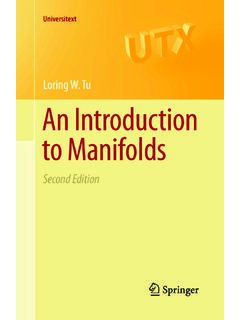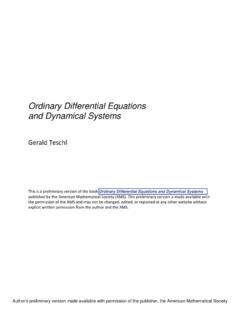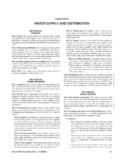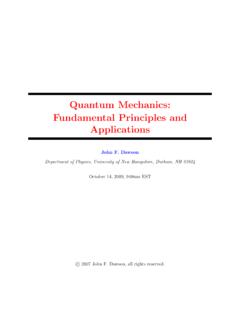Transcription of An Introduction to Manifolds (Second edition)
1 For other titles in this series, go Board(North America):S. Ribet An Introduction to ManifoldsLoring W. TuSecond Edition c Editorial board:Sheldon Axler, San Francisco State UniversityVincenzo Capasso, Universit degli Studi di MilanoCarles Casacuberta, Universitat de BarcelonaAngus MacIntyre, Queen Mary, University of LondonKenneth Ribet, University of California, BerkeleyClaude Sabbah, CNRS, cole PolytechniqueEndre S li, University of OxfordWojbor Woyczy nski, Case Western Reserve UniversityLoring W. TuDepartment of MathematicsTufts UniversityMedford, MA 978-1-4419-7399-3 10013, USA), except for brief excerpts in connection with reviews or scholarly analysis. Use in connectionAll rights reserved. This work may not be translated or copied in whole or in part without the writtenwith any form of information storage and retrieval, electronic adaptation, computer software, or by similaror dissimilar methodology now known or hereafter developed is use in this publication of trade names, trademarks, service marks, and similar terms, even if they arenot identified as such, is not to be taken as an expression of opinion as to whether or not they are subjectto proprietary on acid-free paperSpringer is part of Springer Science+Business Media ( )e-IS BN 978-1-4419-7400-6 DOI of Congress Control Number: Mathematics Subject Classification (2010).
2 58-01, 58 Axx, 58A05, 58A10, 58A12 Springer New York Dordrecht Heidelberg London 2010936466 Springer Science+ Business Media, LLC 2011permission of the publisher (Springer Science+Business Media, LLC, 233 Spring Street, New York, NYDedicated to the memory of Raoul BottPreface to the Second EditionThis is a completely revised edition, with more than fifty pages of new materialscattered throughout. In keeping with the conventional meaning of chapters andsections, I have reorganized the book into twenty-nine sections in seven main additions are Section 20 on the Lie derivative and interior multiplication,two intrinsic operations on a manifold too important to leave out, new criteria inSection 21 for the boundary orientation, and a new appendix on quaternions and thesymplectic from correcting errors and misprints, I have thought through every proofagain, clarified many passages, and added new examples, exercises, hints, and solu-tions. In the process, every section has been rewritten, sometimes quite revisions are so extensive that it is not possible to enumerate them all here.)
3 Eachchapter now comes with an introductory essay giving an overview of what is to provide a timeline for the development of ideas, I have indicated whenever possi-ble the historical origin of the concepts, and have augmented the bibliography withhistorical author needs an audience. In preparing the second edition, I was partic-ularly fortunate to have a loyal and devoted audience of two, George F. Leger andJeffrey D. Carlson, who accompanied me every step of the way. Section by section,they combed through the revision and gave me detailed comments, corrections, andsuggestions. In fact, the two hundred pages of feedback that Jeff wrote was in itself amasterpiece of criticism. Whatever clarity this book finally achieves results in a largemeasure from their effort. To both George and Jeff, I extend my sincere gratitude. Ihave also benefited from the comments and feedback of many other readers, includ-ing those of the copyeditor, David Kramer. Finally, it is a pleasure to thank PhilippeCourr`ege, Mauricio Gutierrez, and Pierre Vogel for helpful discussions, and the In-stitut de Math ematiques de Jussieu and the Universit e Paris Diderot for hosting meduring the revision.
4 As always, I welcome readers , FranceLoring W. TuJune 2010 Preface to the First EditionIt has been more than two decades since Raoul Bott and I publishedDifferentialForms in Algebraic Topology. While this book has enjoyed a certain success, it doesassume some familiarity with Manifolds and so is not so readily accessible to the av-erage first-year graduate student in mathematics. It has been my goal for quite sometime to bridge this gap by writing an elementary Introduction to Manifolds assumingonly one semester of abstract algebra and a year of real analysis. Moreover, giventhe tremendous interaction in the last twenty years between geometry and topologyon the one hand and physics on the other, my intended audience includes not onlybudding mathematicians and advanced undergraduates, but also physicists who wanta solid foundation in geometry and so many excellent books on Manifolds on the market, any author who un-dertakes to write another owes to the public, if not to himself, a good rationale.
5 Firstand foremost is my desire to write a readable but rigorous Introduction that gets thereader quickly up to speed, to the point where for example he or she can computede Rham cohomology of simple second consideration stems from the self-imposed absence of point-set topol-ogy in the prerequisites. Most books laboring under the same constraint define amanifold as a subset of a Euclidean space. This has the disadvantage of makingquotient Manifolds such as projective spaces difficult to understand. My solutionis to make the first four sections of the book independent of point-set topology andto place the necessary point-set topology in an appendix. While reading the firstfour sections, the student should at the same time study Appendix A to acquire thepoint-set topology that will be assumed starting in Section book is meant to be read and studied by a novice. It is not meant to beencyclopedic. Therefore, I discuss only the irreducible minimum of manifold theorythat I think every mathematician should know.
6 I hope that the modesty of the scopeallows the central ideas to emerge more order not to interrupt the flow of the exposition, certain proofs of a moreroutine or computational nature are left as exercises. Other exercises are scatteredthroughout the exposition, in their natural context. In addition to the exercises em-bedded in the text, there are problems at the end of each section. Hints and solutionsxPrefaceto selected exercises and problems are gathered at the end of the book. I have starredthe problems for which complete solutions are book has been conceived as the first volume of a tetralogy on geometryand topology. The second volume isDifferential Forms in Algebraic Topologycitedabove. I hope that Volume 3,Differential Geometry: Connections, Curvature, andCharacteristic Classes, will soon see the light of day. Volume 4,Elements of Equiv-ariant Cohomology, a long-running joint project with Raoul Bott before his passingaway in 2005, is still under project has been ten years in gestation.
7 During this time I have bene-fited from the support and hospitality of many institutions in addition to my own;more specifically, I thank the French Minist`ere de l Enseignement Sup erieur et dela Recherche for a senior fellowship (bourse de haut niveau), the Institut HenriPoincar e, the Institut de Math ematiques de Jussieu, and the Departments of Mathe-matics at the Ecole Normale Sup erieure (rue d Ulm), the Universit e Paris 7, and theUniversit e de Lille, for stays of various length. All of them have contributed in someessential way to the finished owe a debt of gratitude to my colleagues Fulton Gonzalez, Zbigniew Nitecki,and Montserrat Teixidor i Bigas, who tested the manuscript and provided many use-ful comments and corrections, to my students Cristian Gonzalez-Martinez, Christo-pher Watson, and especially Aaron W. Brown and Jeffrey D. Carlson for their de-tailed errata and suggestions for improvement, to Ann Kostant of Springer and herteam John Spiegelman and Elizabeth Loew for editing advice, typesetting, and man-ufacturing, respectively, and to Steve Schnably and Paul G erardin for years of un-wavering moral support.
8 I thank Aaron W. Brown also for preparing the List ofNotations and the TEX files for many of the solutions. Special thanks go to GeorgeLeger for his devotion to all of my book projects and for his careful reading of manyversions of the manuscripts. His encouragement, feedback, and suggestions havebeen invaluable to me in this book as well as in several others. Finally, I want tomention Raoul Bott, whose courses on geometry and topology helped to shape mymathematical thinking and whose exemplary life is an inspiration to us , MassachusettsLoring W. TuJune 2007 ContentsPreface to the Second Edition..viiPreface to the First Edition..ixA Brief Introduction ..1 Chapter 1 Euclidean Spaces 1 Smooth Functions on a Euclidean Space.. Versus Analytic Functions .. Taylor s Theorem with Remainder .. 5 Problems .. 8 2 Tangent Vectors inRnas Derivations.. The Directional Derivative .. Germs of Functions .. Derivations at a Point .. Vector Fields.
9 Vector Fields as Derivations .. 16 Problems .. 17 3 The Exterior Algebra of Multicovectors.. Dual Space.. Permutations .. Multilinear Functions .. The Permutation Action on Multilinear Functions .. The Symmetrizing and Alternating Operators .. The Tensor Product .. The Wedge Product.. Anticommutativity of the Wedge Product .. Associativity of the Wedge Product .. A Basis fork-Covectors .. 31xiiContentsProblems .. 32 4 Differential Forms onRn.. Differential 1-Forms and the Differential of a Function .. Differentialk-Forms .. Differential Forms as Multilinear Functionson Vector Fields .. The Exterior Derivative .. Closed Forms and Exact Forms .. Applications to Vector Calculus .. Convention on Subscripts and Superscripts .. 44 Problems .. 44 Chapter 2 Manifolds 5 Manifolds .. Topological Manifolds .. Compatible Charts .. Smooth Manifolds .
10 Examples of Smooth Manifolds .. 53 Problems .. 57 6 Smooth Maps on a Manifold.. Smooth Functions on a Manifold .. Smooth Maps Between Manifolds .. Diffeomorphisms .. Smoothness in Terms of Components.. Examples of Smooth Maps .. Partial Derivatives .. The Inverse Function Theorem .. 68 Problems .. 70 7 Quotients.. The Quotient Topology .. Continuity of a Map on a Quotient .. Identification of a Subset to a Point .. A Necessary Condition for a Hausdorff Quotient .. Open Equivalence Relations .. Real Projective Space .. The StandardC Atlas on a Real Projective Space .. 79 Problems .. 81 Chapter 3 The Tangent Space 8 The Tangent Space.. The Tangent Space at a Point.. The Differential of a Map .. The Chain Rule .. Bases for the Tangent Space at a Point .. A Local Expression for the Differential .. Curves in a Manifold .. Computing the Differential Using Curves.











